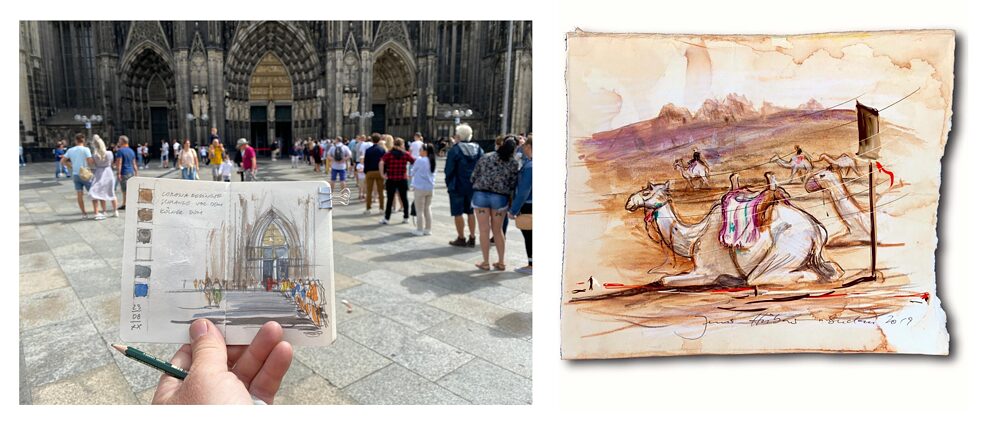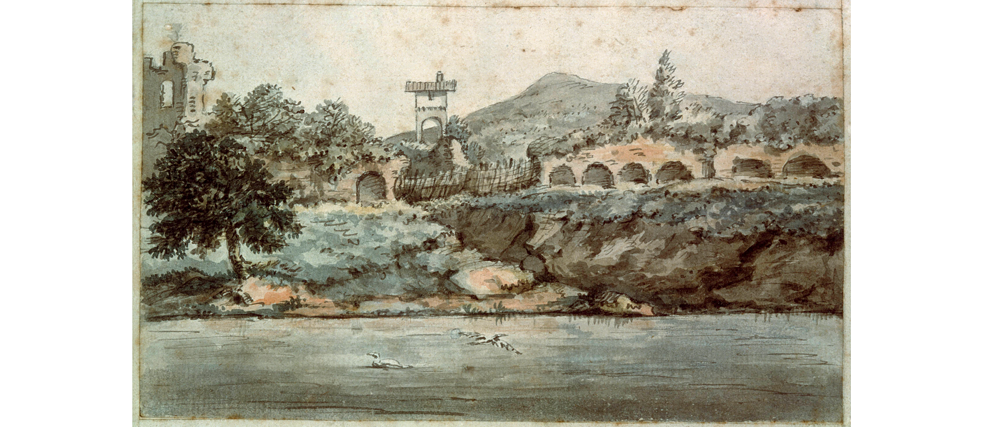Travel Sketching
Seven things and the discovery of slowness

Travel memories that remain unfazed by the deluge of selfies: while some people bring countless smartphone photos home with them from every vacation, travel sketchers use brush and paper to record their impressions.
By Ana Maria Michel
When travelling, there are seven things you should always have with you, says Jens Hübner: a pencil, an eraser, a sharpener, a sketchbook, a brush, a small box of watercolours and a clip. There is not really very much more you need when an opportunity crops up along the way. Jens Huebner, who describes himself as a travel artist, knows that such an opportunity can arise anywhere. It doesn’t matter whether you’re waiting for a bus somewhere or cycling through the Sudan.
 Jens Hübner draws everywhere – at the entrance of the Cologne Cathedral or in the middle of the desert.
| Photo: © Jens Hübner
He graduated with a degree in design, but gave up his office in Berlin 15 years ago to go on a world tour by bike. “Actually, I hadn’t planned to use this trip to draw and paint,” he says. After two years on the road, however, he came back to Germany with more than 200 watercolour images of the things he had seen. In the Czech Republic he quickly pulled out his sketchbook when a wild boar appeared in front of his tent. And that is how it went on during the rest of Hübner’s trip, which took him to Africa and India, among other places, where he even presented his pictures in an exhibition. Jens Hübner then turned this combination of travelling and painting into his profession – a job in which it is also important for him to pass on his knowledge. He now organises workshops and painting trips all over the world, and he also writes instruction manuals.
Jens Hübner draws everywhere – at the entrance of the Cologne Cathedral or in the middle of the desert.
| Photo: © Jens Hübner
He graduated with a degree in design, but gave up his office in Berlin 15 years ago to go on a world tour by bike. “Actually, I hadn’t planned to use this trip to draw and paint,” he says. After two years on the road, however, he came back to Germany with more than 200 watercolour images of the things he had seen. In the Czech Republic he quickly pulled out his sketchbook when a wild boar appeared in front of his tent. And that is how it went on during the rest of Hübner’s trip, which took him to Africa and India, among other places, where he even presented his pictures in an exhibition. Jens Hübner then turned this combination of travelling and painting into his profession – a job in which it is also important for him to pass on his knowledge. He now organises workshops and painting trips all over the world, and he also writes instruction manuals.
The discovery of slowness
According to Jens Hübner, the fact that more and more people are interested in going on trips with their sketchbooks can be put down to “doing-it-yourself” becoming a real trend in recent years. For him, travel sketching is a means of processing the impressions he collects on his travels. He sees drawing as a slower, more intense type of perception – a way of countering the flood of images we are swamped by today.
These days photos can be taken quickly, especially with a mobile phone, but they can sometimes be forgotten just as quickly. It is not uncommon for people to have hundreds of pictures on their smartphones or cameras after a holiday, but no time to actually look at them. On the other hand, those people who are on the lookout for motifs for sketches select very carefully. And then, when they invest a few minutes in a drawing, they can remember the situation more clearly later. For some travel sketchers, the sketchbook becomes a travel diary. With elaborately designed to-do lists and packing ideas, documentation can begin even before the trip. A place like an airport also provides initial motives. Additional notes or glued-in restaurant bills can turn travel sketches into collages full of memories.
In Clermont-Ferrand, France, the Rendez-vous du Carnet de Voyage fair has been taking place for more than 20 years, an event at which around 100 international artists show their travel diaries. The tradition of travel sketching, however, goes back much further – we only have to think of the drawings Johann Wolfgang von Goethe created on his travels. Outdoor painting has been around for even longer – Leonardo da Vinci was painting in natural light as early as the 15th century. Painting en plein air reached its peak in the 19th century with French impressionism.
 The Tiber in Rome: Johann Wolfgang von Goethe also drew on his travels.
| Photo: © picture-alliance/akg-images
The Tiber in Rome: Johann Wolfgang von Goethe also drew on his travels.
| Photo: © picture-alliance/akg-images
From the sketch pad to the web
These days, people who draw or paint on their travels are also able to present their works under hashtags like #pleinair, #travelsketch or #urbansketching. Social media such as Instagram and Facebook are particularly important for the movement of Urban Sketchers. The group was founded on the Flickr platform by Gabriel Campanario, a Seattle-based journalist and illustrator, in 2007. Since then, the Urban Sketchers, who organise international symposia with up to 1,000 participants every year, have grown significantly. All over the world today there are regional groups. The German-speaking Facebook group, for example, has around 3,700 members. For many of them, drawing is a nice hobby, but there are also professional artists involved. According to Omar Jaramillo, one of the founders of the German Urban Sketchers, most of them come from the field of illustration or are, like him, architects.
“Urban sketching is often seen as an analogue activity, but the truth is that it’s strongly connected to social media,” says Jaramillo. This is even anchored in the Urban Sketchers manifesto, which states that members should post their drawings online. With a sketchbook, pencil and watercolours, they want to tell the story of a place and show what they see.
This almost journalistic aspiration is less common in travel sketching, where it is also allowed to use photos as templates and backgrounds or to finish painting a picture in a hotel. Nevertheless, the similarities between urban and travel sketching are very clear. Urban Sketchers draw a lot of images in their own city, but also when travelling. And especially in times of pandemics, even passionate travel sketchers notice that there is also a lot to discover on their own doorstep. “I draw everywhere,” says travel artist, Jens Hübner, who had his best drawing moments in the desert. “Where there is only light and dunes, you can reflect on yourself.”